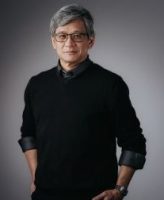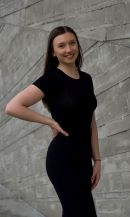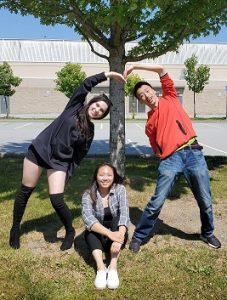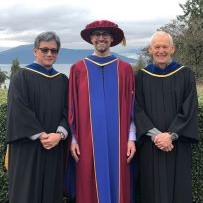The research focus of the Perceptual-Motor Dynamics Laboratory is centered on the study of human perceptual-motor control. The long-term objective of this research program is to understand the neurobehavioural mechanisms underlying the sensory and perceptual contributions to the preparation and execution of goal-directed actions. The research program is motivated by longstanding interests in issues pertaining to:
- the volitional and automatic control of visually-guided action
- the processes underlying sensorimotor adaptation and learning
- the mechanisms underlying motor preparation
A current objective of the lab’s research is to investigate the principles that govern the sensorimotor adaptation of goal-directed actions in the face of systematic perturbations to the sensory/perceptual environment and/or the effector machinery. The capacity of our sensorimotor system to adapt – to detect and correct movement error, to refine our actions and adjust to changing conditions in the environment and/or neuromuscular system – is important to act upon and interact with the world. The aim of this research to further our understanding of sensorimotor adaptation.
The lab is equipped with digital and analog data acquisition systems, including electromyography, electroencephalography, electrophysiological stimulation, 3D motion analysis, and torque motor systems. Software for experiment control and data analyses are written in LabView, Matlab, Visual Basic, and R.

Romeo Chua is the research supervisor of the Perceptual-Motor Dynamics Lab. He obtained a BSc in Kinesiology from Simon Fraser University, an MSc in Human Biodynamics at McMaster University, and completed his PhD in Human Motor Control in Kinesiology at Simon Fraser University. After four winters at the University of Alberta in Edmonton, he moved to his current position in the School of Kinesiology at UBC in 1999.
Current Trainees
 Gregg completed his B.Kin. and M.Sc. degrees at UBC within the School of Kinesiology. During his M.Sc., Gregg was supervised by Dr. Tim Inglis, where his research focused on muscle spindle afferent pathways and their reflexive effects within the central nervous system. Gregg is co-supervised for his Ph.D. by Dr. Romeo Chua and Dr. Tim Inglis, where his work will focus on how the nervous system uses sensory information (such as proprioception, vision, vestibular) to plan and execute goal-directed movements. Gregg has a particular interest in understanding the neurophysiology underpinning sensorimotor control and learning. In his spare time, Gregg enjoys staying active and playing lots of tennis.
Gregg completed his B.Kin. and M.Sc. degrees at UBC within the School of Kinesiology. During his M.Sc., Gregg was supervised by Dr. Tim Inglis, where his research focused on muscle spindle afferent pathways and their reflexive effects within the central nervous system. Gregg is co-supervised for his Ph.D. by Dr. Romeo Chua and Dr. Tim Inglis, where his work will focus on how the nervous system uses sensory information (such as proprioception, vision, vestibular) to plan and execute goal-directed movements. Gregg has a particular interest in understanding the neurophysiology underpinning sensorimotor control and learning. In his spare time, Gregg enjoys staying active and playing lots of tennis.
 Annika completed her B.Kin. within the School of Kinesiology in May 2022. During her degree, she completed a directed studies project examining the contribution of proprioceptive feedback to implicit sensorimotor adaptation. Annika is currently studying human motor control and sensorimotor adaptation through her M.Sc. under the supervision of Dr. Romeo Chua. Outside of her academics, she enjoys going to dance and spin classes.
Annika completed her B.Kin. within the School of Kinesiology in May 2022. During her degree, she completed a directed studies project examining the contribution of proprioceptive feedback to implicit sensorimotor adaptation. Annika is currently studying human motor control and sensorimotor adaptation through her M.Sc. under the supervision of Dr. Romeo Chua. Outside of her academics, she enjoys going to dance and spin classes.
 Nick completed his B.Sc. degree with specialization in Kinesiology at Queen's University. During his degree, he completed an honours thesis project exploring the effect of contextual cues on goal-directed reaches to multisensory targets. Nick is excited to continue his academic journey at UBC. His research will focus on multisensory integration, motor control, and sensorimotor recalibration. Outside of the lab, Nick enjoys running, hiking, and keeping the streets of Vancouver safe from bad guys.
Nick completed his B.Sc. degree with specialization in Kinesiology at Queen's University. During his degree, he completed an honours thesis project exploring the effect of contextual cues on goal-directed reaches to multisensory targets. Nick is excited to continue his academic journey at UBC. His research will focus on multisensory integration, motor control, and sensorimotor recalibration. Outside of the lab, Nick enjoys running, hiking, and keeping the streets of Vancouver safe from bad guys.
Visiting Scholars
 Dr. Sarlegna is a researcher at the French National Center for Scientific Research (CNRS). His line of research aims at better understanding the control mechanisms which underlie human movement. Dr Sarlegna is assessing the roles of vision and proprioception in the control and adaptation of reaching arm movements. In order to address the role of proprioception, he is working with rare individuals deprived of proprioception. Such condition has profounds effects on motor control and also raises questions on the reorganization of sensory and motor systems.
Dr. Sarlegna is a researcher at the French National Center for Scientific Research (CNRS). His line of research aims at better understanding the control mechanisms which underlie human movement. Dr Sarlegna is assessing the roles of vision and proprioception in the control and adaptation of reaching arm movements. In order to address the role of proprioception, he is working with rare individuals deprived of proprioception. Such condition has profounds effects on motor control and also raises questions on the reorganization of sensory and motor systems.
 Jonathan Tsay is a PhD candidate in the Cognition Action Lab at the University of California, Berkeley, working with Dr. Richard Ivry. JT is interested in sensorimotor control, and studies how people acquire and adapt motor skills. He has a background in mathematics and physical therapy from Northwestern University.
Jonathan Tsay is a PhD candidate in the Cognition Action Lab at the University of California, Berkeley, working with Dr. Richard Ivry. JT is interested in sensorimotor control, and studies how people acquire and adapt motor skills. He has a background in mathematics and physical therapy from Northwestern University.
 Dr. Melanie Lam is an Associate Professor in the Department of Human Kinetics at St. Francis Xavier University in Nova Scotia. The general theme of her research is understanding the workings of perception, cognition, and action in a social context. She continues to investigate the underlying cognitive mechanisms of co-representation and the necessary preconditions for successful joint action. During her sabbatical visit to UBC, she is collaborating on investigations on how the temporal features of a co-actor’s responses influence another’s behaviour, and on exploring embodiment in immersive virtual experiences.
Dr. Melanie Lam is an Associate Professor in the Department of Human Kinetics at St. Francis Xavier University in Nova Scotia. The general theme of her research is understanding the workings of perception, cognition, and action in a social context. She continues to investigate the underlying cognitive mechanisms of co-representation and the necessary preconditions for successful joint action. During her sabbatical visit to UBC, she is collaborating on investigations on how the temporal features of a co-actor’s responses influence another’s behaviour, and on exploring embodiment in immersive virtual experiences.
Recent Trainees

- Ada Chang
- Jessica Zhang
- Evita Teng
- Jee Lam
- Ava Dugal
- Thomas Iverson
 Braelyn graduated with her B.Kin. at UBC. She is now in the Master of Physical Therapy program. Braelyn worked on a project investigating the processes underlying sensorimotor integration and perceptual-motor control of movement. She hopes to continue learning more about neuroscience and neuromechanics as a physio by working with individuals with various neurological conditions.
Braelyn graduated with her B.Kin. at UBC. She is now in the Master of Physical Therapy program. Braelyn worked on a project investigating the processes underlying sensorimotor integration and perceptual-motor control of movement. She hopes to continue learning more about neuroscience and neuromechanics as a physio by working with individuals with various neurological conditions.

- Hannah Martin
- Sabrina Hou
- David Yang
 Chris completed his undergrad degree at UBC (Human Kinetics) in 2011 and his MSc in 2013 under the supervision of Ian Franks. He was a member of the PMD lab from 2013-2018 during his PhD. Co-supervised by Ian Franks and Romeo Chua, his dissertation work investigated volitional modulation of rapid feedback responses. During his graduate work, Chris was funded by NSERC, a UBC 4YF, and was recognized with the Franklin Henry Young Scientist Award at SCAPPS. Chris is currently a BrainsCAN Postdoctoral Associate in Paul Gribble’s Lab at Western University.
Chris completed his undergrad degree at UBC (Human Kinetics) in 2011 and his MSc in 2013 under the supervision of Ian Franks. He was a member of the PMD lab from 2013-2018 during his PhD. Co-supervised by Ian Franks and Romeo Chua, his dissertation work investigated volitional modulation of rapid feedback responses. During his graduate work, Chris was funded by NSERC, a UBC 4YF, and was recognized with the Franklin Henry Young Scientist Award at SCAPPS. Chris is currently a BrainsCAN Postdoctoral Associate in Paul Gribble’s Lab at Western University.
During my MSc under the supervision of Dr. Romeo Chua, Damian explored many areas of human motor behaviour. Using simple reaching movements, he investigated topics such as proprioceptive drift and, for his thesis work, tactile perception and multisensory integration. Aside from reaching during experiments, he primarily enjoyed reaching for espresso in the lab. Damian is now pursuing his PhD with Dr. Luc Tremblay in the Perceptual-Motor Behaviour Lab at the University of Toronto.
- Jarrod Blinch PhD
- Brendan Cameron PhD
- Erin Cressman PhD
- Melanie Lam PhD
- Gordon Binsted PhD
- S Bredin PhD
- J Ibbotson MSc
- S Sturrock MSc
- K Ricker MSc
- Brynn Alexander BKin
- Ingrid Yuen BKin
- Tom Kanwischer BKin
- Sarvenaz Heirani Moghaddam BKin
- Kimberly Bennett BKin
- Nicolette Gowan BKin
- Jonathan Kim BKin
- Jada Holmes BKin
- Tavis Bruce BKin
- Laurence Chin BKin
- Annie Maurer BKin
- Hyung Kyung Kim BKin
- Curtis May BKin
- Amy Wang BKin
- Adina Diaconu BKin
- Alex Klemm BKin
- Julia Melanson BKin
- Aly Plecash BKin
- Nicholas Ponzetti BKin
- Cara Rurak BKin
- Lauren Wou BKin
- Melissa Cory BHK
- Silvia Hua BHK
- Chris Dakin BHK
- Andrea Martens BHK
- Rudy Chow BHK
Journals
- Grose, G., Manzone, D.M., Peters, R.M., Eschelmuller, G., Carpenter, M.G., Inglis, J.T., & Chua, R. (2022). The effects of exercise-induced fatigue and eccentric muscle damage on joint position sense during goal-directed movement. Journal of Applied Physiology. doi.org/10.1152/japplphysiol.00177.2021
- Moghaddam, S.H., Decarie, A., Chua, R., & Cressman, E.K. (2022). Assessing explicit processes does not influence the magnitude of implicit processes. Neuroscience Letters, 766, 136341.
- Wijeyaratnam, D.O., Chua, R., & Cressman, E.K. (2022). Changes in Movement Control Processes Following Visuomotor Adaptation. Journal of Motor Behavior, 54, 113–124.
- Zaback, M., Adkin, A.L., Chua, R., Inglis, J.T., & Carpenter, M. G. (2022). Facilitation and Habituation of Cortical and Subcortical Control of Standing Balance Following Repeated Exposure to a Height-related Postural Threat. Neuroscience, 487, 8–25.
- Blinch, J., Holmes, J., Cameron, B.D., & Chua, R. (2021). Investigating information processing of the bimanual asymmetric cost with the response priming technique. Journal of Experimental Psychology: Human Perception and Performance, 47, 673-688.
- Eschelmuller, G., Chua, R., Carpenter, M.G., & Inglis, J.T. (2021). The acute effects of periodic and noisy tendon vibration on wrist muscle stretch responses. Neuroscience Letters, 764, 136279.
- Heirani Moghaddam, S., Chua, R., & Cressman, E.K. (2021). Assessing and defining explicit processes in visuomotor adaptation. Experimental Brain Research, 239, 2025-2041.
- Rasman, B.G., Forbes, P.A., Peters, R.M., Ortiz, O., Franks, I., Inglis, J.T., Chua, R., & Blouin, J.-S. (2021). Learning to stand with unexpected sensorimotor delays. ELife, 10, e65085.
- Dosso, J.A., Chua, R., Weeks, D.J., Turk, D.J., & Kingstone, A. (2019). Attention and awareness: Representation of visuomotor space in split-brain patients. Cortex, 122, 253-262.
- Cleworth, T.W., Adkin, A.L., Allum, J.H.J., Inglis, J.T., Chua, R., Carpenter, M.G. (2019). Postural threat modulates perceptions of balance-related movement during support surface rotations. Neuroscience, 404, 413-422.
- Forgaard, C.J., Franks, I.M., Maslovat, D., & Chua, R. (2019). The influence of kinesthetic motor imagery and effector specificity on the long-latency stretch response. Journal of Neurophysiology, 122, 2187-2200.
- Karlinsky, A., Lam, M.Y., Chua, R., & Hodges, N.J. (2018). Whose turn is it anyway? The moderating role of response-execution certainty on the joint Simon effect. Psychological Research, 83, 833–841.
- Maslovat, D., Klapp, S.T., Forgaard, C.J., Chua, R., & Franks, I.M. (2019). The effect of response complexity on simple reaction time occurs even with a highly predictable imperative stimulus. Neuroscience Letters, 704, 62-66.
- Wijeyaratnam, D.O., Chua, R., & Cressman, E.K. (2019). Going offline: differences in the contributions of movement control processes when reaching in a typical versus novel environment. Experimental Brain Research, 237, 1431-1444.
- Blinch, J., Chua, R., & Youngdeok, K. (2018). Trajectory analysis of discrete goal-directed pointing movements: How many trials are needed for reliable data? Behavior Research Methods, 50, 2162-2172.
- Blinch, J., Franks, I.M., Carpenter, M.G., & Chua, R. (2018). Response selection contributes to the preparation cost for bimanual asymmetric movements. Journal of Motor Behavior, 50, 392-397.
- Forgaard, C.J., Franks, I.M., Bennett, K., Maslovat, D., & Chua, R. (2018). Mechanical perturbations can elicit triggered reactions in the absence of a startle response. Experimental Brain Research, 236, 365-379.
- Manzone, D., Inglis, J.T., Franks, I.M., & Chua, R. (2018). Relevance-dependent modulation of tactile suppression during active, passive and pantomime reach-to-grasp movements. Behavioural Brain Research, 339, 93-105.
- Maslovat, D., Chua, R., Klapp, S.T., Franks, I.M. (2018). Preparation of timing structure involves two independent sub-processes. Psychological Research, 82, 981-996.
- Blinch, J.P., de Cellio Martins G, & Chua, R. (2017). Effects of integrated feedback on discrete bimanual movements in choice reaction time. Experimental Brain Research, 235, 247-257.
- Maslovat, D., Chua, R., & Franks, I.M. (2017). Investigation of timing preparation during response initiation and execution using a startling acoustic stimulus. Experimental Brain Research, 235, 15-27.
- Murnaghan C, Carpenter MG, Chua R & Inglis JT (2017). Keeping still doesn't "make sense": examining a role for movement variability by stabilizing the arm during a postural control task. Journal of Neurophysiology, 117, 846-852.
- Chua, R., Cameron, B.D., & Blinch, J.P. (2016). Volitional initiation and fast visuomotor networks: Why movements are slow to start and quick to correct. Motor Control, 20, 154-161.
- Cleworth, T., Inglis, J.T., Chua, R., & Carpenter, M.G. (2016). Influence of virtual height exposure on postural reactions to support surface translations. Gait and Posture, 47, 96-102.
- Flannigan, J., Chua, R., & Cressman, E.K. (2016). The rapid-chase theory does not extend to movement execution. Consciousness and Cognition, 42, 75-92.
- Forgaard, C.J., Franks, I.M., Maslovat, D., & Chua R. (2016). Perturbation Predictability Can Influence the Long-Latency Stretch Response. PLOS One, 11(10):e0163854.
- Forgaard, C.J., Franks, I.M., Maslovat, D., Gowan, N.J., Kim, J.C., & Chua R. (2016). An examination of the startle response during upper limb stretch perturbations. Neuroscience, 337, 163-176.
- Kennefick, M., Maslovat, D., Chua, R., & Carlsen, A.N. (2016). Corticospinal excitability is reduced in a simple reaction time task requiring complex timing. Journal of Neurophysiology, 1642, 319-326.
- Maslovat, D., Chua, R., Klapp, S.T., & Franks, I.M. (2016). Independent planning of timing and sequencing for complex movements. Journal of Experimental Psychology: Human Perception and Performance, 42, 1158-1172.
- Roberts, J.W., Blinch, J., Elliott, D., Chua, R., Lyons, J.L., & Welsh, T.N. (2016). The violation of Fitts’ Law: an examination displacement biases and corrective submovements. Experimental Brain Research, 234, 151-163.
- Bjerkefors, A., Squair, J.W., Chua, R., Lam, T., Chen, Z., & Carpenter, M.G. (2015). Assessment of abdominal muscle function in individuals with motor complete spinal cord injury above T6 in response to transcranial magnetic stimulation and voluntary activation. Journal of Rehabilitation Medicine, 47, 138-146.
- Blinch, J.P., Cameron, B.D., Franks, I.M., Carpenter, M.G., & Chua, R. (2015). Facilitation and interference during the preparation of bimanual movements: Contributions from starting locations, movement amplitudes, and target locations. Psychological Research, 79, 978-988.
- Blinch, J.P., Franks, I.M., Carpenter, M.G., & Chua, R. (2015). Unified nature of bimanual movements revealed by separating the preparation of each arm. Experimental Brain Research, 233, 1931-1944.
- Forgaard, C.J., Franks, I.M., Maslovat, D., Chin, L., & Chua, R. (2015). Voluntary reaction time and long-latency reflex modulation. Journal of Neurophysiology, 114, 3386-3399.
- Maslovat, D., Chua, R., Carlsen, A.N., May, C., Forgaard, C.J., & Franks, I.M. (2015). A startling acoustic stimulus interferes with upcoming motor preparation: Evidence for a startle refractory period. Acta Psychologica, 158, 36-42.
- Blinch, J.P., Cameron, B.D., Cressman, E.K., Franks, I.M., Carpenter, M.G., & Chua, R. (2014). Comparing movement preparation of unimanual, bimanual symmetric, and bimanual asymmetric movements. Experimental Brain Research, 232, 947-955.
- Murnaghan, C.D., Squair, J.W., Chua, R., Inglis, J.T., & Carpenter, M.G. (2014). Cortical contributions to control of posture during unrestricted and restricted stance. Journal of Neurophysiology, 111, 1920-1926.
- Ong, N.T., Lohse, K., Chua, R., Sinnet, S., & Hodges, N.J. (2014). A test of motor skill-specific action embodiment in ice-hockey players. Acta Psychologica, 150, 61-68.
- Stevenson, A.J.T., Chiu, C., Maslovat, D., Chua, R., Gick, B., Blouin, J-S., Franks, I.M. (2014). Cortical involvement in the startreact effect. Neuroscience, 269, 21-34.
- Campbell, A.D., Squair, J., Chua, R., Inglis, J.T., & Carpenter, M.G. (2013). First trial and StartReact effects induced by balance perturbations to upright stance. Journal of Neurophysiology, 110, 2236-2245.
- Cameron, B.D., Blinch, J.P., Plecash, A., Squair, J., Wou, L., & Chua, R. (2013). Adapting to target error without visual feedback. Acta Psychologica, 143, 129-135.
- Cameron, B.D., Cheng, D.T., Chua, R., van Donkelaar, P., & Binsted, G. (2013). Explicit knowledge and real-time action control: anticipating a change does not make us respond more quickly. Experimental Brain Research, 229, 359-372.
- Cressman, E.K., Lam, M.Y., Franks, I.M., Enns, J.T., & Chua, R. (2013). Unconscious and out of control: Subliminal priming is insensitive to observer expectations. Consciousness and Cognition, 22, 716-728.
- Dakin, C.J., Inglis, J.T., Chua, R., & Blouin, J.S. (2013). Muscle-specific modulation of vestibular reflexes with increased locomotor velocity and cadence. Journal of Neurophysiology, 110, 86-94.
- Forgaard, C.J., Maslovat, D., Carlsen, A.N., Chua, R., & Franks, I.M. (2013). Startle reveals independent preparation and initiation of the triphasic bursts in targeted ballistic movements. Journal of Neurophysiology, 110, 2113-2128.
- Horslen, B.C., Murnaghan, C.D., Inglis, J.T., Chua, R., & Carpenter, M.G. (2013). Effects of postural threat on spinal stretch reflexes: Evidence for increased muscle spindle sensitivity? Journal of Neurophysiology, 110, 899-906.
- Maslovat, D., Chua, R., & Hodges, N.J. (2013). When unintended movements “leak” out: A startling acoustic stimulus can elicit a prepared response during motor imagery and action observation. Neuropsychologia, 51, 838-844.
- Maslovat, D., Chua, R., Spencer, H.C., Forgaard, C.J., Carlsen, A.N., & Franks, .IM. (2013). Evidence for a response preparation bottleneck during dual-task performance: Effect of a startling acoustic stimulus on the psychological refractory period. Acta Psychologica, 144, 481-487.
- Murnaghan, C.D., Squair, J.W., Chua, R., Inglis, J.T., & Carpenter, M.G. (2013). Are increases in COP variability observed when participants are provided explicit verbal cues prior to COM stabilization? Gait & Posture, 38, 734-738.
- Blinch, J.P., Cameron, B.D., Hodges, N.J., & Chua, R. (2012). Do preparation or control processes result in the modulation to Fitts' law for movements to targets with placeholders? Experimental Brain Research, 223, 505-515.
- Cameron, B.D., Franks, I.M., Inglis, J.T., & Chua, R. (2012). The adaptability of self-action perception and movement control when the limb is passively versus actively moved. Consciousness and Cognition, 21, 4-17.
- Campbell, A.D., Chua, R., Inglis, J.T., & Carpenter, M.G. (2012). Startle induces early initiation of classically conditioned postural responses. Journal of Neurophysiology, 108, 2946-2956.
- Houldin, A., Chua, R., Carpenter, M.G., & Lam, T. (2012). Limited interlimb transfer of locomotor adaptations to a velocity-dependent force field during unipedal walking. Journal of Neurophysiology, 108, 943-952.
- Maslovat, D., Kennedy, P.M., Forgaard, C.J., Chua, R., & Franks, I.M. (2012). The effects of prepulse inhibition timing on the startle reflex and reaction time. Neuroscience Letters, 513, 243-247.
- Blouin, J-S., Dakin, C.J., van den Doel , K., Chua, R., McFadyen, B.J., & Inglis, T.J. (2011). Extracting phase-dependent human vestibular reflexes during locomotion using both time and frequency correlation approaches. Journal of Applied Physiology, 111, 1484-1490.
- Blinch, J.P., Cameron, B.D., Franks, I.M., & Chua, R. (2011). Bimanual reaches with symbolic cues exhibit errors in target selection. Experimental Brain Research, 212, 541-554.
- Cameron, B.D., Franks, I.M., Inglis, J.T., & Chua, R. (2011). Reach adaptation to online target error. Experimental Brain Research, 209, 171-180.
- Carlsen, A.N., Lam, M.Y., Maslovat, D., Chua, R. (2011). Reaction time effects due to imperative stimulus modality are absent when a startle elicits a pre-programmed action. Neuroscience Letters, 500, 177-181.
- Carlsen, A.N., Maslovat, D., Lam, M.Y., Chua, R.¸ & Franks, I.M. (2011). Considerations for the use of a startling acoustic stimulus in studies of motor preparation in humans. Neuroscience & Biobehavioral Reviews, 35, 366-376.
- Davis, J.R., Horslen, B.C., Nishikawa, K., Fukushima, K., Chua, R.,Inglis, J.T., & Carpenter, M.G. (2011). Human proprioceptive adaptations during states of height-induced fear and anxiety. Journal of Neurophysiology, 106, 3082-3090.
- Maslovat, D., Hodges, N.J., Chua, R., & Franks, I.M. (2011). Motor preparation of spatially and temporally defined movements: Evidence from startle. Journal of Neurophysiology, 106, 885-894.
- Maslovat, D., Hodges, N.J., Chua, R., & Franks, I.M. (2011). Motor preparation and the effects of practice: Evidence from startle. Behavioral Neuroscience, 125, 226-240.
- Sinnett, S., Hodges, N.J., Chua, R., & Kingstone, A. (2011). Embodiment of motor skills when observing expert and novice athletes. The Quarterly Journal of Experimental Psychology, 64, 657-668.
Please contact Dr. Romeo Chua if interested in inquiring about graduate supervision, volunteer opportunities, or to participate as a participant in one of our ongoing studies.
Room 202, Osborne Centre Unit 2
6108 Thunderbird Boulevard University of British Columbia
Vancouver, BC.
V6T 1Z3
604-822-1339
romeo.chua@ubc.ca